Press Release
A Treasure Chest of Stars -- Dwarf Irregular Galaxy Sextans A
February 23, 2004
 Low Res. (113 KB) Middle Res. (475KB) High Res. (657KB) |
Object Name: Dwarf Irregular Galaxy Sextans A Telescope: Subaru Telescope / Prime Focus Instrument: Suprime-Cam Filter: V (0.55 microns), R (0.65 microns), I (0.80 microns) Color: Blue (V), Green (R), Red (I) Date: UT 2002 November 11 Exposure: 35 min (V), 14 min (R), 24 min (I) Field of View: approx. 13.3 arcmin x 13.3 arcmin Orientation: North up, East left Position: RA (J2000.0) = 10h 11m 1.3s, Dec (J2000.0) = - 4d 42m 48s (Sextans) |
Young blue stars and older yellow and red stars shine against a dark sky like jewels in a treasure chest in this image of Sextans A from Subaru Telescope’s prime focus camera Suprime-Cam. Sextans A is a dwarf irregular galaxy belonging to a group of galaxies called the Antlia-Sextans group 5 million light years from Earth. Even though five million light years is quite distant (50 billion billion kilometers or 30 billion billion miles), only about 40 galaxies are closer to our own Milky Way galaxy than Sextans A. The Antlia-Sextans group is the closest neighbor of the Local Group, which includes both our own Milky Way the Andromeda Galaxy.
Irregular galaxies do not have a regular symmetric shape like spiral or elliptical galaxies. Dwarf irregular galaxies containing only 100 million to a billion stars are the most common type of irregular galaxy. One main characteristic of dwarf irregular galaxies, other than their shape, is vigorous ongoing star formation. Sextans A has a mass comparable to only 100 million stars, one thousandth of the Milky Way, but contains a comparatively large amount of gas and dust, the raw ingredients for stars and planets. In the center of Sextans A is a high concentration of neutral hydrogen gas that serves as a reservoir for the formation of new stars. The Suprime-Cam image shows both young stars (blue) old stars (red) near the center of Sextans A where there is a large reservoir of neutral hydrogen gas and star formation is most vigorous. The green color highlights hydrogen gas ionized by radiation (HII regions) from the blue-hot young stars.
Many dwarf irregular galaxies are surrounded by neutral hydrogen gas that extends far beyond where the galaxy’s starlight fades away. Observations with radio telescopes have confirmed that Sextans A is no exception. The origin of this hydrogen gas and its effect on star formation are still unsolved puzzles. Yutaka Komiyama from Subaru Telescope, the observer of Sextans A, is now working on a solution using the Suprime-Cam data.